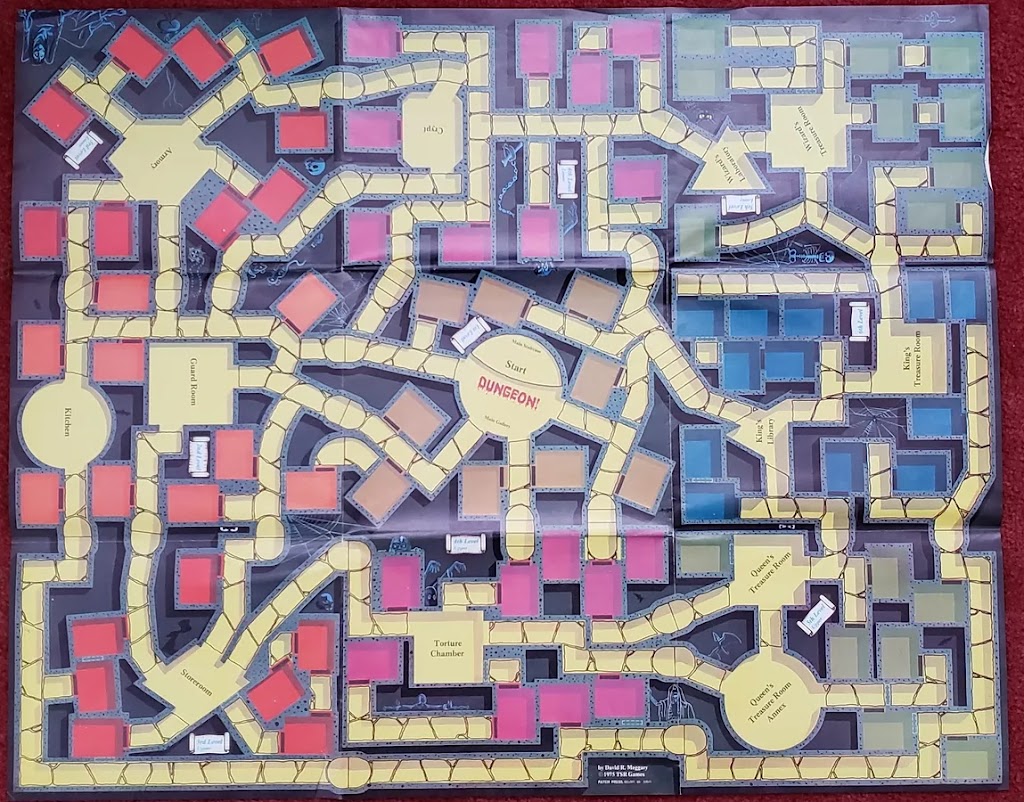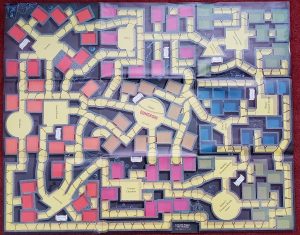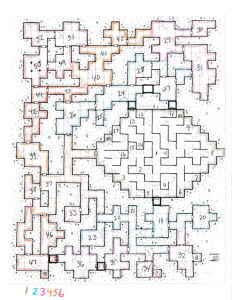I had a problem – I wanted to create a dungeon that would challenge my players with increasing danger, but I didn’t want to make it have multiple levels. I’d never done anything like that before, so I went back to an inspiration that dates from the beginning months of TSR and Dungeons & Dragons.
Back in 1972, a young David Megarry was participating in a new style of game in Minneapolis. As a result of playing this “Blackmoor” game, he had developed a prototype board game based on exploring a dungeon. There’s some thought that this game may have played a hand in influencing the rules of Original Dungeons & Dragons, but the board-game was published in 1975 and called “Dungeon!”.
The idea of Dungeon! was that players would navigate a dungeon displayed as a single level on a board, but was actually divided up into six distinct areas. As players navigated to the different areas, the treasures would become larger, but the monsters would be more dangerous!
This concept became the way I was going to take this map I had stashed from 2017 [1] and apply an approach to stocking it as inspired by the board game.
 |
| Map by Steve/PrismaticDM (see [1]) |
First, I had to make the map a bit more connected, so I connected the initial maze area to the left and right for more paths and not single bottlenecks. Then I had to decide what would be “first level”, “second level” and so on, and I ended up with this:
There are six distinct “areas/levels” but instead of bunching them together like the board game, I made them more like an onion. So level 1 – the olive color – is the maze area. Lower level creatures/encounters are here.
Blue – level 2, are a bit harder with the foes. Purple – level 3 – and so on. Level 6 – the upper left of this map, was the endgame of the dungeon, with the Macguffin that the players sought.
It worked out very well! The campaign experienced a cycling of players – as two of the more experienced players had to drop out and the newer players were only first level! I was worried that they might bite off more than they could chew, so I warned the players of the nature of the dungeon – if they thought this all was “level 1″… they were in for a rough go!
They ended up succeeding by luck and careful exploration, finding the least difficult path to their goal, and not exploring any of the rest of the dungeon.
I think it’s worth noting that myself and Dungeon! aren’t the only ones to follow this sort of flat/onion approach. I think a case can be made for B2’s Caves of Chaos following a similar approach.
So if you’re wanting to give your players a challenging dungeon experience, but creating five or six levels is difficult due to time, take it from one of the founding voices of this hobby – David Megarry – a board game can show a different and just as interesting approach!
[1] I’m apparently a pack-rat of interesting maps, because I have a great number of maps over the years, but little kept in the way of where I got them! I wanted to give credit for the source map, but I had no clue who did it! It wasn’t a Dyson Logos map, as the artist-mark was different than his, and the shading in of negative space was done as stones and pebbles, instead of the cross-hatching that is Dyson’s signature style.
After some poking around on social media and posing questions in various places, “Heliagon” (ev_maps on Instagram) from the Cartographer’s Guild forum found the source via a website called
tineye.com. The original map I found in 2017 comes from the talented mind/hand of Steve, aka PrismaticDM of the “Borderlands” blog and Dize Roll Zine Ramblings podcast. His original post of the map is here:
https://dndborderlands.blogspot.com/2017/03/friday-map-15-mazeverse-of-nubraxas.htmlThank you Steve, and Heliagon!



